Template:Realworld Originally build for Star Trek III: The Search for Spock, the studio models for the Template:ShipClass have been in used in five of the Star Trek films and all three of the shows set in the 24th century, making the Excelsior-class the most frequently seen "guest-star" Federation starship in the Star Trek franchise. Apart from the "hero" models, the various Excelsior-class models (or stock footage thereof), appear in both the series premieres of Star Trek: The Next Generation and Star Trek: Deep Space Nine, and the series finales of Deep Space Nine and Star Trek: Voyager.
Design
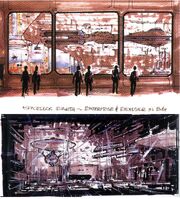
Early design concepts of the Excelsior-class
For Star Trek III: The Search for Spock, which was (tied with TNG: "The Best of Both Worlds, Part II", seven each) until Star Trek: First Contact the Star Trek production that introduced the most new space faring designs at once, an unique approach to designing was adopted, not seen before or after in the Star Trek franchise. Instead of the traditional way of thinking out a design, devising a design, coming up with detailed drawings to be approved of by effects supervisors and building models from blueprints, this time visual artists David Carson and Nilo Rodis-Jamero of Industrial Light & Magic produced their pre-visualization artwork and handed it over to model makers Steve Gawley, Bill George and their team to be translated into study models, in essence inviting them to use their own imagination to finish up on the design. Very much a collaborative effort, Carson later remembered,"We'd churn out quite a few sketches. Then the ones that were most promising we might polish up a little in color for presentation. It wasn't uncommon for me to do a drawing that would inspire Nilo, who would then turn it into his own drawing that would be much more impressive! He would often inspire me." (Star Trek: The Magazine Volume 3, Issue 8, p. 48) Once turned over to the model makers the resulting study models were presented to producer Harve Bennett and/or director Leonard Nimoy for appraisal or as supervising model maker Gawley put it,"You had all these models sitting on a table so that the director could really get a feel for what we were talking about. It just made everything easier to understand, and insured that everybody was on the same page. It also made it easier to give cost estimates." (Star Trek: The Magazine Volume 3, Issue 8, p. 20) Director of Photography Kenneth Ralston elaborated further, "From the beginning, once Nilo Rodis, one of the visual effects art directors, had done a sketch and they got an idea of what direction to go, the model people all built prototypes. The space dock had four or five small prototypes. The Bird of Prey, I think, had only two because we all knew this one design would work and we were selling that one. The Merchant Man and the Grissom also had several designs. When Leonard and Harve and Ralph Winter came to meetings we presented them with three dimensional models. It really is a lot better doing it that way because they can physically see how different angles would work." (American Cinematographer, August/September 1984, p. 62)
In the specific case of the Excelsior Rodis recalled, "The “Excelsior” had to be brilliant, and it had to steal thunder from the Enterprise.", to which Carson added, "We kicked around a few different ways to go with the “Excelsior”, but when Nilo did the drawing that led to the eventual design that was it, because it was very well received. It seemed to me to be a believable extension-a kind of next generation design." (Star Trek: The Magazine Volume 3, Issue 9, pp. 66-67)
Study models
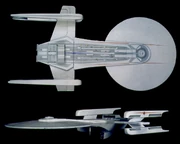
Four-engined study model variant
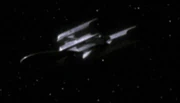
...at Surplus Depot Z15
The Rodis/Carson sketches, once approved, were sent down to ILM's model shop of Bill George who commented, "The art department had done a number of sketches. All of them were very different and very futuristic. They still had the basic theme of the dish and the engines, but they did not look like the “Enterprise” at all. I was given the job of building prototypes of those sketches. Leonard Nimoy was going to come up and look at them and hopefully choose one." (Star Trek: The Magazine Volume 3, Issue 9, p. 67)
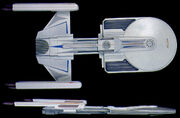
Study model of the USS Alka-Selsior
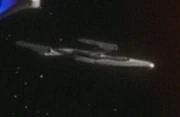
...at Surplus Depot Z15
Some of the study models based upon Rodis' designs found their way into canon however. A two-engined model, flippantly labelled USS Alka-Selsior (NCC-1404) found its way into the debris-field of Surplus Depot Z15 in the episode TNG: "Unification II". Two four-engined variants, one of which with pivoting warp nacelles (a feature not canonically encountered till the advent of the USS Voyager), were also present in the scene. The models therefore became canon albeit without class designations or names.

Another four-engined study model, pivoting engines variant
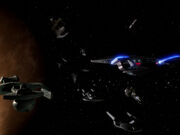
...at Surplus Depot Z15
Nilo's designs were all thin and long and George finished up upon the study models in good time. With time to spare Carson proposed to George to come up with his own ideas, who did, explaining, "When you're designing something you want to come up with a take on it that will drive the design. At the time I was really into Japanese design, so I thought, “OK, what would the “Enterprise” look like if the Japanese designed it?” That was the basis of what I came up with for the “Excelsior”".(Star Trek: The Magazine Volume 3, Issue 9, p. 70)
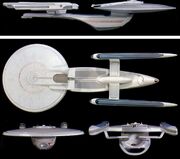
Bill George's study models
Upon this premise, George built a couple of study models, which had a deeper profile and a more rounded secondary hull section (one of which had a nacelle type later applied to the Template:ShipClass). A bit to his surprise, Nimoy chose one of his refinements as the template for the final studio model or as he has put it, "What's funny is I think that's what Leonard responded to. When laid out all these things on the table, he pointed to the study model that I had done and said “That one.” And I think it was just because it was so much more familiar. It was quite a surprise when I found out that was the one he wanted. There were a couple of the other study models that I really liked, and I certainly hadn't trying to figure out which one he was going to choose."(Star Trek: The Magazine Volume 3, Issue 9, p. 70)

Design patent image
The mere fact that Nimoy did choose one of George's models, warranted him his status as one of the co-designers of the Excelsior-Class, though he was not acknowledged as such on design patent, No. D288945, that was issued to Paramount Pictures by the US Patent and Trademark Office for the USS Excelsior on 24 March 1987 (there described as "The ornamental design for a toy spaceship"). Andrew Probert's earlier patents for the starships in The Motion Picture, attributed to him in these cases, were cited as past references, as was the USS Reliant. The patent application was tendered by the studio on 29 November 1984, valid for fourteen years when issued.
"The mysterious four-nacelled ship appears to have been another Excelsior study model built by Bill George for Star Trek III. I think there might have been a photo of it in one of the "art-of" books. We had at least three or four of those Bill George models kicking around. One of them is still hanging in the DS9 graphics department.", Michael Okuda later recalled in regard to the graveyard scene in TNG: "The Best of Both Worlds".[1]. The Excelsior study models have, however, never been identified as being in the on-screen scene. Yet, as the Unification depot scenes were mostly composited from shots previously made for the former episode, it is feasible the models were filmed, but that the footage was originally not used.
The fixed four nacelled variant study model ended up in Okuda's personal collection, and eventually showed up as Lot 45 in the Propworx' STAR TREK auction of 4 June 2011. Damaged from years of storage and missing two of its nacelles it was estimated at $1,000-$2,000, selling for $1,400 ($1,722 with buyer's premium).
The original physical model

Early publicity photo of the studio model
The 7.5 feet long studio model was built at Industrial Light & Magic's model shop under the supervision of Steve Gawley. Building upon the experience they had garnered from the construction of the the USS Reliant model in the previous outing, they made sure that the model made for easy handling and assembling by constructing it out of lightweight vacuformed pieces with easy access to the innards of the model. The model went on to make additional appearances in Star Trek IV: The Voyage Home and Star Trek V: The Final Frontier (though there stock footage from Star Trek IV was utilized). (Star Trek: The Magazine Volume 3, Issue 9, p. 70)
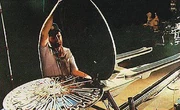
Steve Gawley checks the Hood "under the hood"
In 1987 the model was again at ILM, as the company was contracted to compile a library of stock footage for TNG: "Encounter at Farpoint". As the scrip called for the appearance of the USS Hood (Excelsior class) (the first ever appearance of an Exclsior-class vessel other than the "Excelsior" herself) she was relabeled as "USS Hood NCC-2541".[2]. As no dorsal views were ever used in the series, the registry number was never seen and apparently forgotten about, as the Hood was later endowed with a much higher number for her appearances in Deep Space Nine. The stock footage shot at ILM for the episode was extensively used throughout the entire run of the series and no new footage was ever shot for The Next Generation.
Excelsior-class modifications
In 1991, the model was refurbished and partly modified for its appearance in Star Trek VI: The Undiscovered Country, yet again at ILM´s model shop. The bridge module was replaced with a smaller one, the large impulse deflector crystal was replaced with two smaller ones and the rounded, what is on the MSD designated as "aft crew lounge", was replaced with a more angular one. As for the bridge Bill George rationalized, "We changed the bridge on the Excelsior model because on this show, the bridge is actually very small-it's the Enterprise bridge re-dressed. The Excelsior was originally built for Star Trek III, where it had a cavernous bridge, and the model had a big bubble on top which I felt was always out of scale. We replaced it with a smaller bridge area which helped the overall scale of the model." (American Cinematographer, January 1992, pp. 58-59) Part of the refurbishment was the replacement of the Hood decals with the new call sign for the USS Excelsior, NCC-2000.
A year later, the model was filmed in its original configuration one last time at Image G for its appearance as the USS Melbourne in DS9: "Emissary". The shot of the two unnamed Excelsior-class vessels shown at the end of the 1995 DS9: "The Way of the Warrior" episode was probably composited from previously unused stock footage filmed for Emissary, as the model by that time had already been converted into the USS Enterprise-B.
Redesign
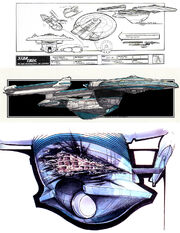
Eaves' redesign sketches

The refit Excelsior-class studio model
For the production of Star Trek Generations, the "producers [...] felt that the Excelsior had been seen too many times in previous films; they wanted a brand-new design for the Enterprise-B. This presented a challenge how to maintain continuity and Trek “historical accuracy” while giving the audience a “new” ship. Mike Okuda felt the challenge could be met." (Star Trek: The Next Generation Sketchbook: The Movies, p. 4)
The modifications designed for the Enterprise-B were created by John Eaves, with the assistance of Okuda. According to Eaves: "[Mike] pointed out that we needed to design an area that protruded from the ship, so that the energy ribbon could whip out a section while leaving most of the ship intact." As a result, Eaves, who originally imaged the damage higher up near the neck of the ship, subsequently re-positioned the damage on the section of decks that extended out from the hull, which he had designed surrounding the deflector dish tapering gently on the bottom and flaring out dramatically on the top. Eaves elaborated that "the addition of the decks gave the B's belly section a look similar to that of a PBY Catalina (a flying boat of the 1940s)." Ultimately their modifications produced added girth to the design, which increased its overall size, while still retaining the original Excelsior design. (Star Trek: The Next Generation Sketchbook: The Movies, p. 4) The Catalina also served as inspiration for Eaves in adding the two additional impulse engines, one on either side of the existing impulse engines, "To seek out inspiration the PBY Catalina came to mind with it’s built in boat like belly detail which made for the perfect reference to re translate into the Starship’s new hull lines. As for the big wing top props the same is seen on the top of the saucer with twin impulse engines located on the back of the dish." [3]
Additional modifications made to the model included the removal of the two fins off the top of the saucer. The nacelles "capped" and a dorsal fin was added to the top, along with the inclusion of a running fin along the outer edge of the nacelles. (Star Trek: The Next Generation Sketchbook: The Movies, pp. 4-12)
Once the new design was approved by production designer Herman Zimmerman and executive producer Rick Berman, the new sketches were sent to Visual Effects supervisor Bill George, who passed them on to ILM's model shop for conversion of the the existing Excelsior model into the Enterprise-B under supervision of lead modeler John Goodson. (Star Trek: The Next Generation Sketchbook: The Movies, p. 8)
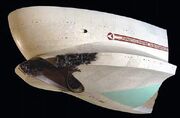
Hull section studio model
For the scene where the damage caused by the Nexus is shown up close, a enlarged section of the redesigned forward secondary hull section was needed, both in order as not to damage the studio model as well as to show more detail. "This model was built for an extreme close up shot of the ship's hull, revealing the dramatic extent of the damage, telling the audience that Kirk had no chance of survival.", Okuda later elaborated. (Christie's Auction Catalog, Part One, 2006, p.66) The model, measuring 94"×54"×33" (as large as the studio model itself) was constructed out of wood, acrylic, glass fiber/resin and etched brass construction (for the exposed decks). The model showed up in the 40 Years of Star Trek: The Collection auction as Lot #106 with an estimated sale price of US$1,500 to US$2,000; it sold on 5 October 2006 for US$4,500 (US$5,400 with premium).
The Enterprise-B model was returned to Image G for use in the DS9: "Paradise Lost" episode as the USS Lakota. "We had to take off all the detailing, the numbers and names, and make new ones. Mike Okuda was instrumental in cutting us new decals and actually showing us how to get the old ones off without destroying the paint job. We did a lot of hand rubbing with water.", effects supervisor Glenn Neufeld later recalled. (Star Trek: Deep Space Nine Companion, p. 302) It was the last time the model was used as a production asset.
The Enterprise-B/Lakota model (measuring 92"×12"×32"), still wearing its Lakota markings, was listed as Lot #998 in the "40 Years of Star Trek: The Collection" auction with an estimated sale price of US$3,000 to US$5,000; it sold on 7 October 2006 for US$110,000 (US$132,000 with premium). [4] A much smaller concept model (measuring 14.34"×7"×3") was later sold on as Lot# 7265 It's A Wrap! sale and auction for US$511.99 (clearly an unfinished AMT model kit, No.8761, it is more likely it was either a camera test model or an unfinished kitbash for DS9: "A Time to Stand"). Also sold off on IAW was an Excelsior- class starship schematic lot, drawn by J. Moll in 1992. [5]
The Jein model
The Excelsior in "Flashback" with glowing warp nacelles
When an original configuration of the Excelsior was needed for the VOY: "Flashback" episode it was discovered that the original model could not be returned to its original configuration without causing damage to it. A new one was therefore built by Greg Jein at a smaller scale for expedience sake, with minor differences – even though it was supposedly the same ship as seen earlier. For example, "Flashback" features the only appearances of the USS Excelsior's warp nacelles glowing, although the episode also incorporated footage from Star Trek VI in which the nacelle sides did not glow. Built at approximately half-scale of the original model, it made for much easier handling at Image G (in the process partially explaining why a refit-Excelsior class vessel was no longer seen) and continued to be reused until a CGI Excelsior was built for later seasons of DS9 and Voyager. It has been relabeled once for DS9: "A Time to Stand" as Okuda later confirmed, "The “USS Fredrickson” was indeed a re-use of the small Excelsior model that Greg Jein built for “Flashback” (VGR). It was done for a DS9 episode."[6] (In this guise the model was featured in the Inside the Star Trek Archives special of TNG Season 2 DVD, disc six, where it was revealed that the pennants, bearing the original name, on the sides of the model were not replaced). The last time the model or rather stock footage thereof was used was in DS9: "Behind the Lines".
The model, unlike its bigger sister, has been retained by Paramount Pictures, and has, relabeled back to USS Excelsior, been featured in tour displays such as Star Trek World Tour, Star Trek: The Exhibition and Star Trek: The Adventure as late as 2011.[7][8]
A limited edition of twelve, without internal lighting, built from the same mold as the Jein studio model, was later sold, in 1997, with a certificate of authenticity signed by Jein at the "Viacom Store" in Chicago.Template:Brokenlink
Other physical models
Unlike with, for example the Template:ShipClass or Template:ShipClass, it has yet to be ascertained with any certainty whether there were commercially available models used, if any, to serve as stand-ins for the studio models in scenes in any of the Star Trek productions. That being said, behind-the-scenes photos taken at Image G have shown up on John Eaves' blog revealing at least one AMT model kit (No. 6630). It can be discerned that the mounting rod is attached to the dorsal side, suggesting that it might have been used as deep background elements in the episode DS9: "Call to Arms", the next to last episode where new footage of the Excelsior class using physical models was shot, along with the Jein model, that one having been used as foreground elements.[9] Still, what is certain is that for the DS9: "A Time to Stand" episode, liberal use was made of AMT model kits, to create the kitbash models of the Template:ShipType, Raging Queen, the unseen USS Hutzel[10] and most prominently the Template:ShipType.[11]
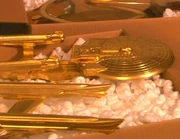
An USS Enterprise-B golden display model
Commercial products did show up however, to represent the Excelsior class as display models. The golden models in the display cabinet in the observation lounge of the USS Enterprise-E in Star Trek: First Contact, were all especially prepared commercial merchandise by John Eaves. For the Enterprise-B he used a Playmates Toys toy model (Item 6172), filled it up with resin and had it gold plated at ArtCraft Plating.[12] For Star Trek: Insurrection Eaves repeated the procedure, this time using three AMT model kits No. 8761, though due to a late script change they were not used there. They did turn up in Star Trek Nemesis.[13] The studio initially retained most of the models but one was sold as part of a complete set of six in the Profiles in History Hollywood Auction #44 on 15 May 2011 as Lot 1550 for $11,000 (for the whole set), and another one has reportedly been sold in an on-line Sotheby's auction in October 2000.[14]
A silver refit-Excelsior model was seen in admiral Leyton's office at Starfleet Headquarters on the Presidio in DS9: "Paradise Lost". This probably was a painted AMT model kit No. 8761.
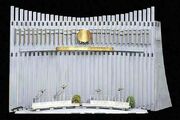
Starfleet Headquarters model with mounted Excelsior-class vessel on the far right
Another commercial product was used as one of the four models mounted in front of the sail shaped top half facade of the Starfleet Headquarters on the Presidio, appearing in DS9: "Homefront", "Paradise Lost". The top half of the facade was itself a studio model and the starship models were Galoob Micro Machines (most likely taken from the pewter painted "Star Trek Television Series I Box Set" and "Star Trek the Movies Collectors Edition" sets). (Star Trek: The Magazine Volume 1, Issue 13, p. 112) The Excelsior-class vessel was mounted on the far right.
CGI models
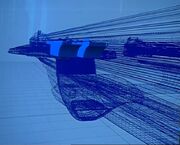

ILM's CGI model in action
After discovering, during the production of Star Trek Generations, how well the CGI models of the Template:ShipClass worked in combination with the likewise conceived CGI Nexus effect, such as controlling the interactive light and being able to move the models freely within the phenomena, ILM's visual effects supervisor John Knoll after conferring with co-supervisor Alex Seiden and CG supervisor John Schlag, decided to digitize the Enterprise-B as well for its scenes within the Nexus. "All the shots of the Enterprise-B in the Ribbon were done with computer graphics. The decision allowed us to have particles streaming around the Enterprise as though they were deflected by the shields, and to do effects with tighter interaction than we could've gotten away with using motion control", Knoll explained.(American Cinematographer, April 1995, p. 85)
Computer graphic artist Stewart Lew constructed the CGI wire-frame model from flat-lit photographs taken from the physical studio model. Those photos were also used by Scott Frankel and Ben Snow to map and texture Lew's model in ViewPoint, a software program that allowed 3-D manipulation.(Cinefex, No.61, p. 68) "To "render" the skin of the Enterprise-B, we actually took a bunch of flatly lit detail photographs of the ship with a real long lens from directly above and below, from both sides, and from front and back. Since the geometry of the CG Enterprise-B matched the the photographs of the motion-control model, it matched the motion-control model exactly when we laid the texture maps that were derived from those same photos over that geometry!", Knoll elaborated.(American Cinematographer, April 1995, p. 85) As construction on the physical model was still under way at that time, photography and texturing had to be regularly updated to keep pace with the changes.
When in 1997, during the pre-production of sixth season Star Trek: Deep Space Nine, it became clear that events would lead up to the massive climatic battle in "Sacrifice of Angels", visual effects supervisors were aware that that battle was impossible to realize using traditional motion-control photography. "The problem is that motion control is about shooting one ship at a time, one pass at a time. There was just no way we could have done it. We just didn't have enough time or money.", David Stipes explained.(Star Trek: Deep Space Nine Companion, p. 501) In order to pull this off it was decided to complete the transition to CGI. Due to the scale of the project it was decided to divide the workload up between Digital Muse, who would transform the Federation starships to CGI and Foundation Imaging who were responsible for the alien ships.
Part of the process was the decision to greatly improve efficiency by employing one software format only, LightWave 3d. This entailed turning over existing CGI models, done in other software formats, to Digital Muse for re-programming and re-rendering in "LightWave", including the ILM models done for Star Trek Generations and Star Trek: First Contact. The majority of them were converted, but for some reason the Enterprise-B was not one of them, either because it was overlooked or for technical reasons.

Digital Muse's CGI model in action
Instead a new CGI model was built at Digital Muse, using the Jein model as reference, incorporating its characteristics, such as the glowing nacelle sides, and also serving as an additional explanation why the refit-Excelsior class was no longer seen. Built and rendered by modeler David Lombardi [15], the model made its debut in DS9: "Favor the Bold", and continued to be used to represent the class for the remainder of both the Star Trek: Deep Space Nine and Star Trek: Voyager series.
The model did not meet everyone's approval as Foundation's supervisor Adam Lebowitz later explained, "A few years back, when I was working on a Star Trek book for Simon & Schuster, I hired Ed [Giddings] to help out with modeling chores. The CGI Excelsior model we had used on DS9 wasn’t very detailed, so I asked Ed to create a new one. Armed with a ton of reference photos of the physical model, he went to work, sending me daily progress images, upon which I would scribble notes and make suggestions. After a few weeks, Ed put the finishing touches on what is easily the best CG model of the Excelsior to date, matching the studio model rivet by rivet."[16]
Appendices
Related topics
External links
- Template:Exastris
- Designing the Excelsior at Forgotten Trek
